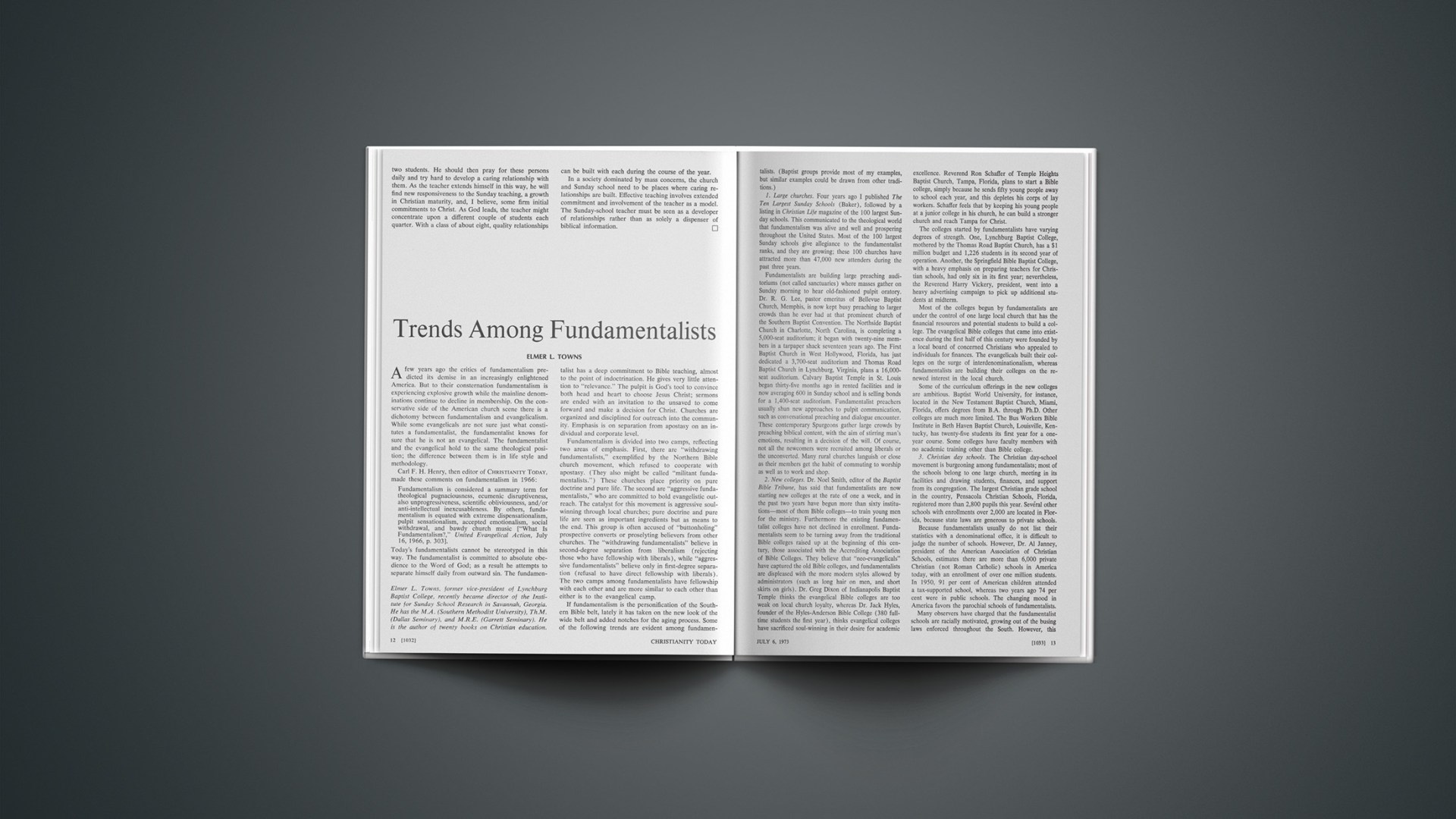A few years ago the critics of fundamentalism predicted its demise in an increasingly enlightened America. But to their consternation fundamentalism is experiencing explosive growth while the mainline denominations continue to decline in membership. On the conservative side of the American church scene there is a dichotomy between fundamentalism and evangelicalism. While some evangelicals are not sure just what constitutes a fundamentalist, the fundamentalist knows for sure that he is not an evangelical. The fundamentalist and the evangelical hold to the same theological position; the difference between them is in life style and methodology.
Carl F. H. Henry, then editor of CHRISTIANITY TODAY, made these comments on fundamentalism in 1966:
Fundamentalism is considered a summary term for theological pugnaciousness, ecumenic disruptiveness, also unprogressiveness, scientific obliviousness, and/or anti-intellectual inexcusableness. By others, fundamentalism is equated with extreme dispensationalism, pulpit sensationalism, accepted emotionalism, social withdrawal, and bawdy church music [“What Is Fundamentalism?,” United Evangelical Action, July 16, 1966, p. 303].
Today’s fundamentalists cannot be stereotyped in this way. The fundamentalist is committed to absolute obedience to the Word of God; as a result he attempts to separate himself daily from outward sin. The fundamentalist has a deep commitment to Bible teaching, almost to the point of indoctrination. He gives very little attention to “relevance.” The pulpit is God’s tool to convince both head and heart to choose Jesus Christ; sermons are ended with an invitation to the unsaved to come forward and make a decision for Christ. Churches are organized and disciplined for outreach into the community. Emphasis is on separation from apostasy on an individual and corporate level.
Fundamentalism is divided into two camps, reflecting two areas of emphasis. First, there are “withdrawing fundamentalists,” exemplified by the Northern Bible church movement, which refused to cooperate with apostasy. (They also might be called “militant fundamentalists.”) These churches place priority on pure doctrine and pure life. The second are “aggressive fundamentalists,” who are committed to bold evangelistic outreach. The catalyst for this movement is aggressive soul-winning through local churches; pure doctrine and pure life are seen as important ingredients but as means to the end. This group is often accused of “buttonholing” prospective converts or proselyting believers from other churches. The “withdrawing fundamentalists” believe in second-degree separation from liberalism (rejecting those who have fellowship with liberals), while “aggressive fundamentalists” believe only in first-degree separation (refusal to have direct fellowship with liberals). The two camps among fundamentalists have fellowship with each other and are more similar to each other than either is to the evangelical camp.
If fundamentalism is the personification of the Southern Bible belt, lately it has taken on the new look of the wide belt and added notches for the aging process. Some of the following trends are evident among fundamentalists. (Baptist groups provide most of my examples, but similar examples could be drawn from other traditions.)
1. Large churches. Four years ago I published The Ten Largest Sunday Schools (Baker), followed by a listing in Christian Life magazine of the 100 largest Sunday schools. This communicated to the theological world that fundamentalism was alive and well and prospering throughout the United States. Most of the 100 largest Sunday schools give allegiance to the fundamentalist ranks, and they are growing; these 100 churches have attracted more than 47,000 new attenders during the past three years.
Fundamentalists are building large preaching auditoriums (not called sanctuaries) where masses gather on Sunday morning to hear old-fashioned pulpit oratory. Dr. R. G. Lee, pastor emeritus of Bellevue Baptist Church, Memphis, is now kept busy preaching to larger crowds than he ever had at that prominent church of the Southern Baptist Convention. The Northside Baptist Church in Charlotte, North Carolina, is completing a 5,000-seat auditorium; it began with twenty-nine members in a tarpaper shack seventeen years ago. The First Baptist Church in West Hollywood, Florida, has just dedicated a 3,700-seat auditorium and Thomas Road Baptist Church in Lynchburg, Virginia, plans a 16,000-seat auditorium. Calvary Baptist Temple in St. Louis began thirty-five months ago in rented facilities and is now averaging 600 in Sunday school and is selling bonds for a 1,400-seat auditorium. Fundamentalist preachers usually shun new approaches to pulpit communication, such as conversational preaching and dialogue encounter. These contemporary Spurgeons gather large crowds by preaching biblical content, with the aim of stirring man’s emotions, resulting in a decision of the will. Of course, not all the newcomers were recruited among liberals or the unconverted. Many rural churches languish or close as their members get the habit of commuting to worship as well as to work and shop.
2. New colleges. Dr. Noel Smith, editor of the Baptist Bible Tribune, has said that fundamentalists are now starting new colleges at the rate of one a week, and in the past two years have begun more than sixty institutions—most of them Bible colleges—to train young men for the ministry. Furthermore the existing fundamentalist colleges have not declined in enrollment. Fundamentalists seem to be turning away from the traditional Bible colleges raised up at the beginning of this century, those associated with the Accrediting Association of Bible Colleges. They believe that “neo-evangelicals” have captured the old Bible colleges, and fundamentalists are displeased with the more modern styles allowed by administrators (such as long hair on men, and short skirts on girls). Dr. Greg Dixon of Indianapolis Baptist Temple thinks the evangelical Bible colleges are too weak on local church loyalty, whereas Dr. Jack Hyles, founder of the Hyles-Anderson Bible College (380 fulltime students the first year), thinks evangelical colleges have sacrificed soul-winning in their desire for academic excellence. Reverend Ron Schaffer of Temple Heights Baptist Church, Tampa, Florida, plans to start a Bible college, simply because he sends fifty young people away to school each year, and this depletes his corps of lay workers. Schaffer feels that by keeping his young people at a junior college in his church, he can build a stronger church and reach Tampa for Christ.
The colleges started by fundamentalists have varying degrees of strength. One, Lynchburg Baptist College, mothered by the Thomas Road Baptist Church, has a $1 million budget and 1,226 students in its second year of operation. Another, the Springfield Bible Baptist College, with a heavy emphasis on preparing teachers for Christian schools, had only six in its first year; nevertheless, the Reverend Harry Vickery, president, went into a heavy advertising campaign to pick up additional students at midterm.
Most of the colleges begun by fundamentalists are under the control of one large local church that has the financial resources and potential students to build a college. The evangelical Bible colleges that came into existence during the first half of this century were founded by a local board of concerned Christians who appealed to individuals for finances. The evangelicals built their colleges on the surge of interdenominationalism, whereas fundamentalists are building their colleges on the renewed interest in the local church.
Some of the curriculum offerings in the new colleges are ambitious. Baptist World University, for instance, located in the New Testament Baptist Church, Miami, Florida, offers degrees from B.A. through Ph.D. Other colleges are much more limited. The Bus Workers Bible Institute in Beth Haven Baptist Church, Louisville, Kentucky, has twenty-five students its first year for a one-year course. Some colleges have faculty members with no academic training other than Bible college.
3. Christian day schools. The Christian day-school movement is burgeoning among fundamentalists; most of the schools belong to one large church, meeting in its facilities and drawing students, finances, and support from its congregation. The largest Christian grade school in the country, Pensacola Christian Schools, Florida, registered more than 2,800 pupils this year. Several other schools with enrollments over 2,000 are located in Florida, because state laws are generous to private schools.
Because fundamentalists usually do not list their statistics with a denominational office, it is difficult to judge the number of schools. However, Dr. Al Janney, president of the American Association of Christian Schools, estimates there are more than 6,000 private Christian (not Roman Catholic) schools in America today, with an enrollment of over one million students. In 1950, 91 per cent of American children attended a tax-supported school, whereas two years ago 74 per cent were in public schools. The changing mood in America favors the parochial schools of fundamentalists.
Many observers have charged that the fundamentalist schools are racially motivated, growing out of the busing laws enforced throughout the South. However, this slanderous generalization does not stand up, because many of these same churches bus black children to their Sunday schools. The growth of Christian day schools comes from four sources: (1) a desire for biblical education for children; (2) a desire for quality education for children that is thought to be synonymous with discipline, reflected by the McGuffey’s Reader that is used in many schools; (3) a desire to escape the violence and tension in public schools; and (4) a desire to promote a deep-seated patriotic conservatism, which fundamentalists charge is absent in public schools.
The growth of these schools, with their high tuition, has given financial leverage to local churches to build larger and better buildings, resulting in added space for Sunday-school expansion. Fundamentalists now have some fine facilities and classrooms: carpeting throughout, plastic-molded armchairs, and well-lighted, public-school-sized rooms.
4. The master teacher plan. The Sunday schools in fundamentalist churches are rapidly moving toward large, open-session classrooms that resemble a modified team-teach approach to education. The traditional small Sunday-school cubicles are no longer adequate. Competent teachers instruct large classes, surrounded by a corps of helpers who specialize in such areas as singing, story-telling, memorization, and handwork. The master teacher uses effective stimulus-response psychology in teaching that reinforces indoctrination, which is a characteristic of fundamentalism. When the church mounts a large attendance drive, the Sunday-school class with the master teacher can accommodate an extra wave of children on Sunday morning, whereas the traditional Sunday-school organization with small classes for every ten pupils would be inundated and ineffective.
5. Curriculum. Most fundamentalist churches prepare their own Sunday-school lessons, rather than purchase materials from a publisher. The entire Sunday school usually studies the same lesson, with a heavy emphasis on mastery of Bible content, memorization of Bible verses, and application to everyday life. These pastors suspect denominational and interdenominational publishers, even though many of those publishers grew up in the fundamentalist movement years ago. Dr. John Rawlings, pastor of Landmark Baptist Temple in Cincinnati, says, “How can these publishers know my needs? They unconsciously suggest church organization that is contrary to the way we do it.”
6. Local church conferences. The Sunday-school movement among evangelicals has flourished through Sunday-school conventions, the National Sunday School Association being the grandfather convention. The smaller conventions at the state, city, and denominational levels were aimed at teaching Sunday-school workers how to do it. Leaders at these evangelical conventions have generally been Sunday-school publishing-house personnel and professors from evangelical Bible colleges. However, the fundamentalists are gathering for seminars and conventions sponsored by a single church, with the thrust of “how we did it” rather than the evangelicals’ focus on “how to do it.” For eleven years Dr. Jack Hyles at Hammond, Indiana, had averaged more than 1,000 pastors at his annual pastors’ school, and many think the growth of fundamentalism is due in part to the training pastors have received from Hyles. Last year Dr. Jerry Falwell (Thomas Road Baptist Church, Lynchburg, Virginia) registered more than 5,600 at a pastors’ conference, and this year a number of other fundamentalist pastors are beginning conferences, inviting their friends to come in and see “how we did it.”
7. Media explosion. The fundamentalist preacher has always been stereotyped as the “radio evangelist,” and many fundamentalists have felt the epitome of gospel ministry is a fifteen-minute daily radio outreach to the city. Fundamentalists are continuing their use of radio but sophisticating their outreach. Many churches back up the broadcast ministry with a printed weekly periodical reporting the work of the church through news, pictures, and articles. Dr. Jerry Falwell, in a pastors’ seminar, said, “Every pastor should have a printing press and typesetting equipment.” Literally thousands of them have followed his advice and are saturating their communities through the newspaper.
In the last year there has been a mass move to television, stocking the Sunday-morning channels with religious programs and televising Sunday-morning services. Thirty-two of the 100 largest churches have a weekly television ministry.
8. Church campus. A few years ago the average church was happy with a five-acre plot of ground; however, the trend among fundamentalists is to get 100 acres or more on an expressway or main thoroughfare and build a total church-living complex. Dr. Hyles is building Baptist City, with a senior citizens’ home, orphanage, and schools, kindergarten through college. Faith City, in Tampa, Florida, is located fifty miles from Disney World and will include a ranch for boys, a college campus, an orphanage, a senior citizens’ home, Sunday-school and church buildings, a bus garage, lakes, and parks. FaithWay, a campus planned by Ypsilanti (Michigan) Baptist Temple, includes all the above, plus bookstores, printing facilities, and a home for men from the city mission. As other pastors plan church campuses, they are anticipating Christian banks, cafeterias, doctors’ offices, counseling centers, day-care centers, motels—and, one pastor even said, “a beauty shop where women can get their hair curled to the glory of God.”
The multiphase ministry among fundamentalists is built on the synergistic principle. Sociologists have taught that innovation in American life begins with the business community, moves through government and education, and finally influences the church. The shopping center illustrates the synergistic principle: two major stores, surrounded by a number of specialty shops, will attract twelve times as many customers as only one large department store. When shopping centers became a reality in the early fifties, sociologists predicted that the synergistic principle would make an impact on the churches during the seventies. The large churches with many ministries fulfill that prediction.
Ernest Troeltsch in Social Teaching of the Christian Churches says that new movements of Christianity begin as seeds and evolve through a sociological cycle into a denominational-church type. Fundamentalists reflect the life style of sectarian Christianity and will continue to come into existence and evolve as the liberal-denominational aspect of the church deteriorates. Whether the reader agrees with fundamentalism or not, he can’t ignore its existence or present growth.
The future looks bright for fundamentalists, but the upward trend is not automatic; they will have to continue diligent work for more gains. Whereas Wheaton became the center for evangelical Christianity, eventually a new catalyst will emerge (not yet discernible). Already new mission boards, publishing houses, and Bible conference grounds are coming into existence. Magazines for fundamentalists are gaining in subscriptions. New heroes draw allegiance; fundamentalists are disillusioned with the evangelical leaders.
Even though fundamentalism is growing, it is not yet as large as the liberal establishment. And even though fundamental churches are growing, the mood of the country does not favor orthodoxy. They will have to work harder to make inroads and conserve their gains than they did twenty years ago. Most fundamentalists are not the aggressive fighters of liberalism found in the past; they have learned that little progress is made through winning debates or “showing up” the modernists. Most fundamentalists channel their “aggressions” into an organized work, knowing that the greatest blow against liberalism is to win its lost church members to Christ and get them into a Bible-believing church.
Today’s fundamentalists understand the dynamics that make them strong. They appreciate “relevance”-oriented ministries, yet are not swayed from their church practices, based on a literal understanding of the New Testament church. They have a commitment to revivalism with a foundation of Bible teaching, the former related to emotionalism, the latter to indoctrination. Whereas a typical American church emphasizes the common man and his place in the ministry, the fundamentalist elevates the leader. The fundamentalists recognize the leader must not be a modern “Elmer Gantry,” yet must take “the oversight thereof … neither as being lords over God’s heritage” (1 Pet. 5:2, 3). Knowing the dynamics inherent in sectarian Christianity, modern-day fundamentalists are evolving into a discernible movement. The future does not belong to the decaying liberal establishment but to those who will take it by faith.
George M. Marsden is associate professor of history at Calvin College, Grand Rapids, Michigan. He has the Ph.D. (Yale University) and has written “The Evangelical Mind and the New School Presbyterian Experience.”










